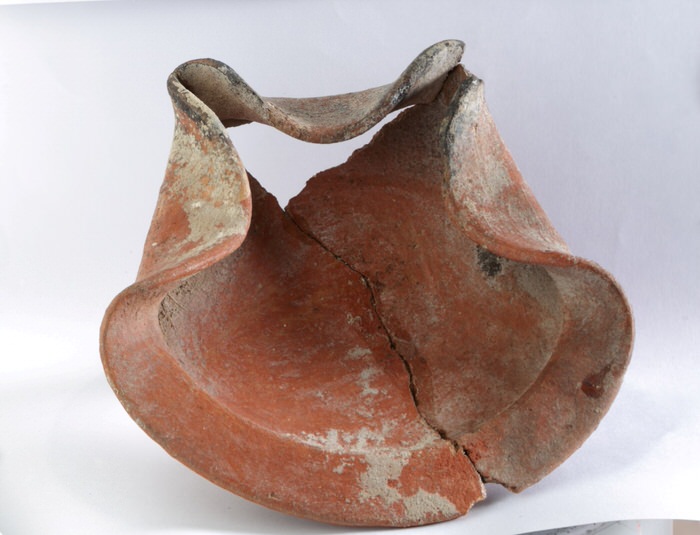Two-spout oil lamp
The two-spout oil lamp (fig. 1) was found in fragments inside tomb 9 PGM in the Phoenician-Punic necropolis of Sulky. Almost entirely recomposed, although there remains a gap in the area of the nozzles, it can be dated to the fifth century B.C. according to the burial context.

At the bottom of the lamp, there is a kind of handle which helped to facilitate transport (fig. 2) and it is characterised by two spouts and by a very simple shape, created by simply modifying a dish.

The two-spout oil lamp which spreads between the VII and V centuries B.C., was chronologically preceded by the so-called "single-spout" oil lamp, i.e. with only one nozzle (fig. 3), in use during the first Phoenician expansion and which characterises the VIII century B.C.: for this reason, many examples of this type were found in the Tophets, in the sanctuary, that is, where dead new-born or stillborn children were buried and where the gods were asked for the grace of a new birth. In addition to the two types we have just seen, there is a third one, the so-called “cup” oil lamp, so named because it resembles a small cup and which spread during the late Punic Age (IV-III centuries B.C.) (fig. 4).


What were oil lamps used for? In all likelihood, in addition to illuminating the darkness of the burial chambers during the funeral, they were often left lit inside the tomb so that they could be used by the deceased to face his journey to the afterlife.
Bibliografia
- E. ACQUARO, P. BARTOLONI, Interazioni fenicie nel Mediterraneo centrale: l’Africa e la Sardegna, in L. SERRA (a cura di), Gli interscambi culturali e socio-economici fra l'Africa settentrionale e l'Europa mediterranea. Atti del Congresso Internazionale di Amalfi, (5-8 dicembre 1983),Napoli 1986, pp. 191-228.
- P. BARTOLONI, , Lucerne arcaiche da Sulci in AA.VV., Sardinia in the Mediterranean . A footprint in the sea. Studies in Sardinian Archaeology presented to Miriam S. Balmuth (Monograph in Mediterranean Archaeology,3), Sheffield 1992, pp. 419-423.
- S. MUSCUSO, Il Museo “F. Barreca” di Sant’Antioco: le tipologie vascolari della necropoli di Sulky = Sardinia Corsica et Baleares Antiquae VI, 2008, pp. 9-39.

 VR
VR